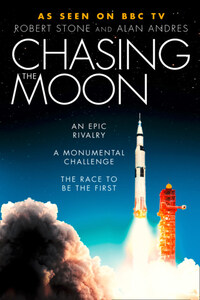William Collins
An imprint of HarperCollinsPublishers 1 London Bridge Street London SE1 9GF WilliamCollinsBooks.com
This eBook first published in Great Britain by William Collins in 2019
First published in the United States by Ballentine Books, an imprint of Random House, a division of Penguin Random House, LLC, New York
Copyright © Alan Andres and Robert Stone
Insert photos courtesy of NASA unless otherwise indicated
“AMERICAN EXPERIENCE”™ is a trademark of the WGBH Educational Foundation.
Used with permission
Grateful acknowledgement is made to Tom Lehrer for permission to reprint an excerpt from “Wernher von Braun” by Tom Lehrer, copyright © 1965 by Tom Lehrer. Reprinted by permission of the author
Alan Andres and Robert Stone assert the moral right to be identified as the authors of this work in accordance with the Copyright, Designs and Patents Act 1988.
Cover image © Getty Images
A catalogue record for this book is available from the British Library.
All rights reserved under International and Pan-American Copyright Conventions. By payment of the required fees, you have been granted the non-exclusive, non-transferable right to access and read the text of this e-book on-screen. No part of this text may be reproduced, transmitted, down-loaded, decompiled, reverse engineered, or stored in or introduced into any information storage and retrieval system, in any form or by any means, whether electronic or mechanical, now known or hereinafter invented, without the express written permission of HarperCollins.
Source ISBN: 9780008307875
eBook Edition © June 2019 ISBN: 9780008307851
Version: 2019-05-30
For my mother, who awakened her ten-year-old son in the middle of an English midsummer night to watch Neil Armstrong and Buzz Aldrin make history as they walked on the Moon.
—R.S.
For Charlie, older brother and teenage rocket scientist, who, as the youngest accredited journalist covering the launch of Apollo 14, backpacked and hitchhiked 1200 miles to Cape Kennedy.
— A.A.
COVER
TITLE PAGE
COPYRIGHT
DEDICATION
PROLOGUE JULY 16, 1969
CHAPTER ONE A PLACE BEYOND THE SKY (1903–1950)
CHAPTER TWO THE MAN WHO SOLD THE MOON (1952–1960)
CHAPTER THREE THE NEW FRONTIER (1961–1963)
CHAPTER FOUR WELCOME TO THE SPACE AGE (1964–1966)
CHAPTER FIVE EARTHRISE (1967–1968)
CHAPTER SIX MAGNIFICENT DESOLATION (1969)
CHAPTER SEVEN THE FINAL FRONTIER (1970–1979)
APPENDIX AFTER A FEW MORE REVOLUTIONS AROUND THE SUN
PICTURE SECTION
ACKNOWLEDGMENTS
NOTES
INDEX
ABOUT THE AUTHORS
ABOUT THE TYPE
ABOUT THE BOOK
ABOUT THE PUBLISHER
THE SUN BEGAN rising over the northeast coast of Florida on what would be a humid subtropical mid-July morning. The brown pelicans swooping over the dunes sensed the day was anything but typical. Parked tightly together on the sides of the narrow roads to the beaches and causeways were thousands of cars and campers. The air carried the thrumming sound of helicopters ferrying visitors to the Kennedy Space Center. Since shortly after sunrise, all the roads to the Cape had become clogged with traffic.
Nearly a million people were gathering under the harsh Florida sun to witness the departure of the first humans to attempt a landing on another world, the Earth’s moon, 239,000 miles away. Should it be successful, the piloted lunar landing would culminate a decade of mounting anticipation.
Eight years earlier, President John Kennedy stood before Congress and called for the United States to put a man on the Moon and return him safely to Earth before the end of the decade. At the time, the Soviet Union’s commanding position in space appeared assured. They had been the first to launch an artificial satellite, the first to fly past the Moon, and, in a one-hundred-eight-minute flight, the first to orbit a human around the Earth. When Kennedy addressed Congress, the suborbital flight of the only American to venture into space had been less than fifteen minutes.
But by July 1969, as America readied to launch Apollo 11 from the space center bearing the name of the late president, the Soviet space threat had receded. This would be the twenty-first piloted NASA space mission; in comparison, the Russian total was twelve, and all had remained in low earth orbit. Now the richest nation on Earth was about to undertake a daring technological feat of unprecedented magnitude, a demonstration of national will framed as a world media event. It was a story of courage, adventure, and scientific exploration as well as an exercise in geopolitics.
If not for the persuasive influence of a select group of visionaries, this moment in history would have been inconceivable. For some it was the fulfillment of a personal dream dating back to childhood. For others it was a way to promote democracy, extend human knowledge, and establish the nation’s technological and academic preeminence. Some saw it as humanity’s inevitable evolutionary destiny; others their personal patriotic duty.
A few hundred feet south of the giant Vehicle Assembly Building, where the Saturn V moon rocket had been put together, a balding middle-aged Englishman dressed in a gray suit looked toward the launchpad from CBS News’s temporary broadcast facility. Arthur C. Clarke had imagined this day since his teenage years, having co-authored one of the first serious publications about a possible expedition to the Moon. He was scheduled to appear on live television with CBS’s veteran newsman Walter Cronkite shortly after Apollo 11’s liftoff. During the preceding year, Clarke’s reputation as a leading author of science fiction had risen to greater prominence due to his association as co-writer of director Stanley Kubrick’s 2001: A Space Odyssey, the top-grossing film of 1968. For Clarke, the moon landing would establish the extraterrestrial presence of Homo sapiens in the cosmos, with a promise of what the human race might achieve in the future.








